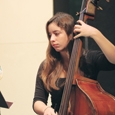At the urging of some friends who insisted I would pick it up quickly in spite of the fact that I had never seriously studied a string instrument before, I signed up for a month of bass guitar lessons in January. Here are my thoughts and experiences.
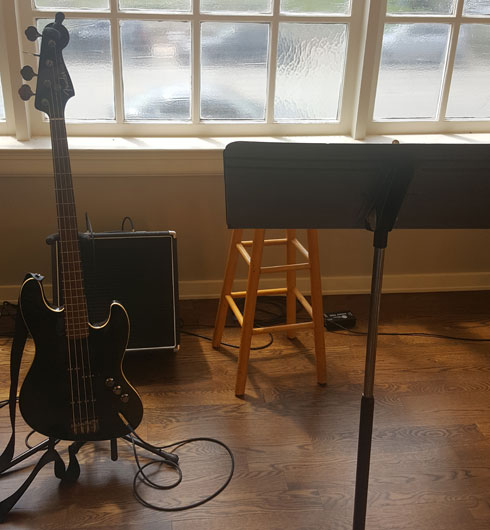
January 8: First Lesson
My right thumb appears to be my first obstacle. My initial approach to playing the bass was to strum with it, but my teacher, Kitt Lyles, a Northwestern University graduate, said it was better to strum with the first and second fingers. Thumb playing isn’t necessarily wrong, but it won’t be much good in fast passages. Unfortunately, using the first and second fingers made me want to rest my thumb on top of the instrument, which will cause an overly stretched hand when playing on the G and D strings. My teacher rests his thumb on the A string when playing on the G string and on the E string when playing on the D and A strings. Playing A on the G string causes the A string to vibrate sympathetically, but resting the thumb there prevents that.
I was surprised to learn that pushing down on the string is better than pulling up on it. The first exercise of the lesson was playing open strings to get into this habit. When playing the A, D, or G strings, the finger should come to rest on the string above it. We set a metronome to 60, and the teacher had me play four quarter notes per string, from E to G and back up the instrument.

Going down was simple enough, but coming back up is going to take practice. Moving from G to D (or D to A etc.) I already had both index and middle fingers resting on the higher string, starting me with a dead note from accidental muffling. My teacher referred to a dominant finger, meaning starting with either index or middle every downbeat. He also said that moving up could be an exception to this. He recommended a dominant middle finger, as it is longer and stronger than the index.
The second exercise assigned for the week was chromatics, starting on the open G and putting down one finger per fret up to fourth-finger B. One of my only memories from a college string techniques course 21 years ago was using only first, second, and fourth finger on the bass, so I wasn’t expecting to have to use the third finger on its own, but my teacher pointed out that it was better to develop the dexterity that comes with using it, because I would need it.
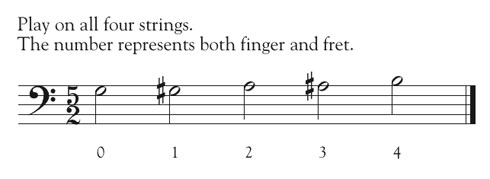
I have a lot of work to do on keeping my left hand curved. I like to bend my left thumb backward, plant it someplace, and never move it, and while it is used to help support the instrument, playing will be easier if I keep my hand curved. I have big enough hands, but they’re mostly palm; my tiny pinky finger struggles to reach and press down hard enough, especially on the E string.
I never knew where on the fretboard I was supposed to press down. (I also didn’t realize that the little bars on the fretboard were the frets; for some reason I thought the frets were the spaces between. In hindsight, the term fretless makes a lot more sense now.) My teacher said to press down (finger?) right behind the fret, rather than on it. This sweet spot is easier to press down than exactly in between frets and also eliminates buzzing. There was a lot of buzzing today. Developing the muscle memory to land where I should is going to take some work.
After some work on chromatics and all the coordination that comes with playing them (coordination that I lack), the teacher asked me to play a G major scale without using open strings. He showed me that the finger pattern (2-4-1-2-4-1-3-4) works starting from anyplace on the fretboard, which is convenient if I don’t want to think, but I want to know where all the notes are. I might look into downloading an app that helps me review this.

The lesson ended with the opening line from Cream’s Sunshine of Your Love.

The minor third at the end of the line was a rough stretch between index finger and pinky, and when I pointed out an easier alternate fingering, my teacher agreed, said he used that with younger students, but I should stretch.
January 9: 30-Minute Practice Session
I’m having trouble balancing the instrument. I am following my teacher’s instructions for holding the bass while seated, but it feels like it’s taking the attention of too many body parts away from performance technique. On my way out of the store I spent seven dollars on a strap. I like the laziness of sitting while playing, but tomorrow I’m going to try standing up and wearing the strap to see if it’s easier to focus on good technique playing this way.
I am doing well at pushing down on the strings to play rather than pulling at them. It’s easy to be self-critical, but it’s important to acknowledge things that are going well. Baby steps and all that.
I have also had a bit of success with that first exercise going up and down the strings, but only at q = 30. A couple habits learned long ago are getting in the way, even though they are good habits for wind and percussion players. Back in beginning band (in 1986), the director was a stickler for being ready to play the next note by fingering it early whenever possible. This 32-year-old habit makes my brain want to put a finger down on the string I’m going to play next even while it’s still vibrating, choking off the note before I mean to. Adding to this, when moving from the G string to the D string, I seem to want to be a timpanist and muffle the ringing G string with my right hand instead of the left as my teacher told me to do. There might not be anything wrong with right-hand string muffling, but I can see how it could make playing a faster passage needlessly complicated.
Something new to practice: I am getting good at starting with my middle finger, but stroke (pick? strum?) strength is wildly inconsistent from note to note. Also, when I try the chromatic exercise I learned yesterday, there is no rhyme or reason to which finger I use at any given time. Tomorrow I might spend some time just playing quarter or eighth notes on one string to work on both a consistent sound and going back and forth between second and first fingers. It seems like an easy and good thing to commit to muscle memory as soon as possible.
January 10: 45-Minute Practice Session
Using the shoulder strap helped immensely, whether sitting or standing. I’m curious why my teacher didn’t insist on it, and slightly worried that doing this on my own means I’ve fallen into some sort of bad habit.
I’m playing a bit better than yesterday. At the end of the day, that’s the goal. Moving up and down open strings (especially up) is getting easier, and I get it right more often than I mess it up, even after just two days. Plucking consistency is improved as well. There is still a lot of work to do, though.
I took time out to watch a couple YouTube videos of bassists playing and noticed that they move their left hands around, whereas I like to plant mine and not ever move it. This is probably something to practice harder tomorrow.
Chromatics (and hitting the right spots on the fretboard) are coming easier as well, at least on the G string. D and A are tougher, and I can barely reach the E string. The width of the bass neck seems to be roughly equal to the length of my pinky. A different teacher said the flexibility would come in time and that I should consider practicing chromatics on frets 5-8 rather than 1-4.
I also wondered if they make smaller-sized bass guitars. My question was answered at the end of my practice session, when I discovered something called a short-scale bass hanging near the one I’ve been using to practice on. (The store lets teachers and students borrow instruments off the wall to use for lessons.) I might play with it tomorrow a bit and will definitely ask my teacher about the differences between the two sizes. A brief internet search offers varying opinions (no surprise there), but one common statement is that the short-scale basses work well with flat-wound strings, whatever those are.
January 11: 40-Minute Practice Session
I’m tired today and don’t feel like practicing, but I went anyway, choosing instead to ignore the laundry pile I’ve been putting off. I’m glad I went; after just two more sessions, the frustration I felt in my first practice session is more or less gone. There is still a great deal of work to do – and that is just on these first basic exercises – but I think I’ll be able to handle it now.
Moving on open strings was mostly flawless. Every now and then when I mute a string with the left hand I accidentally sound the note attached to whatever fret I touched, but that will stop eventually, too. On chromatics, I’m getting buzzing sounds on the E string and sometimes the A string, but the muscle memory is starting to come.
Much of the work today was on the G major scale, which I’ve been neglecting in favor of the other two exercises. Going up the scale is quite a bit easier than coming back down. The primary problem is moving from E, played on the D string to D, played on the A string. My right hand forgets to change strings, but because that open D is the correct note anyway, everything gets jumbled up in my mind. I’m supposed to practice the scale in half notes at q = 60, but I worked the scale in whole notes and then dotted half notes at that same speed, which helped. One thing I should have done but didn’t think of at the time was just practice going back and forth between E and D (and also between B and A, the point at which I change from the A string to the E string.
I spent the last ten minutes of my session trying a short-scale bass. It’s a lot easier to hold and to play, but I’ll wait to play one again until after I get my teacher’s take on them. I called up a video of MEUTE’s cover of You & Me by Disclosure and Eliza Doolittle (Flume Remix). It’s in Bb minor, which isn’t the best key for a beginning bassist, but it has a slow tempo, one chord per measure, and some extremely easy licks in the bass line, so it made a good note-finding exercise. I still haven’t found an app I like for this purpose.
January 13: 50-Minute Practice Session
I played a perfect G scale at the tempo my teacher assigned today. Only once, but you have to start somewhere. I forgot to practice the string changes I mentioned Friday; I’ve made a note to practice that tomorrow night.
The biggest problems I can see at the moment are some rattling, which seems to be caused primarily by me wanting to move to the next note too soon, and still being entirely random in whether I use my index or middle finger to play.
I put in a little time on the Cream lick tonight. It ends with a minor third played by going from first to fourth finger and back on the same string, and it’s quite a reach. I took some time just to work on the minor third, which seemed to help.
I feel ready for my second lesson. There will always be more improvement to be made, but practicing pays off.
January 15: Second Lesson
I opened the lesson asking about short-scale basses. My teacher grabbed one off the wall and play-tested it, showing me how the tone knobs on the instrument and the amp affected the sound. He took the bass all the way from a bright and punchy sound to a deep, dancehall-style woof bass. Ultimately, he proclaimed it fine, and he gave me the short-scale bass he grabbed to use for my lesson, although he also had us compare hand sizes, and his proportions match mine almost exactly
The move to a smaller instrument barely affected everything I had practiced on the standard-sized instrument. For the open strings exercise, we moved to eighth notes, both straight and with accents on 1 and 3, the ands of one and three, 2 and 4, and the ands of 2 and 4. We also did all these exercises with a left hand finger on the third fret. My teacher said it was okay that I changed which finger was fretting as I went up and down the strings.
Adding accents to this exercise also helped with alternating between the first and second fingers, which is still something that needs work.
At this point conversation turned to the Cream lick, and I mentioned that I was having trouble stretching between first and fourth fingers. The exercise he gave me was to use only first and fourth fingers and increase the distance each time:

This is also a good exercise to practice shifting hand position.
The chromatic scale has been expanded. Rather than 0-1-2-3-4 on one string at a time, I’m playing a scale from low E to B on the G string. It’s still 0-1-2-3-4, but also moving from one string to the next.
I have also been assigned to G scale at twice the speed (quarter notes at 60 instead of half notes). This has further expanded to C, F, Bb, Eb, and Ab scales. It is the same pattern for all; I just need to know where on the fretboard to start.
January 16: 30-Minute Session
Scales are coming well. It helps that it’s the same pattern for every key; I just need more work on finding the starting note.
Yesterday during my lesson, my teacher showed me a good hand position away from the bass. I put my own hand in that position and took a picture of it with my cell phone. It’s a good reference to have.
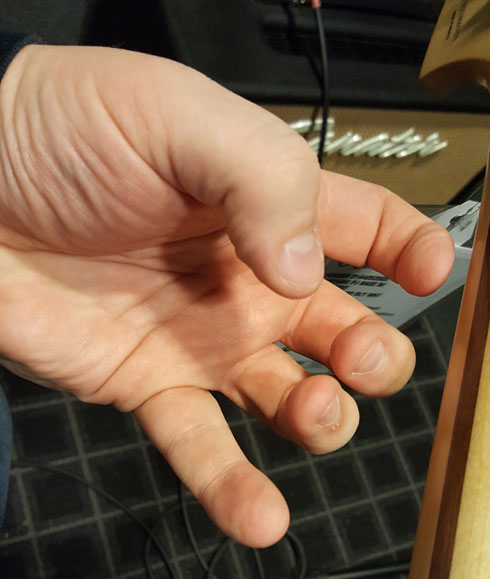
I’m having a difficult time making accented notes sound different from regular notes and am struggling to figure a way to practice this. It might be time to check YouTube for inspiration.
Overall, this was a productive, but unremarkable practice session. Sometimes there are breakthroughs, but sometimes, you’re just putting the work in to get better.
I ended today by pulling up a YouTube video of Cream’s Sunshine of Your Love and playing along. The song is somewhat faster than I’ve been running the lick, but I went through the whole thing anyway. Stumbling full-speed through music is a terrible way to practice, and I got the lick wrong much more than I got it right, but it was fun to play along with something.
January 17
No practice today. I have to be somewhere at 6:00 a.m. tomorrow morning.
January 18
No practice today. We are supposed to get a foot of snow, starting around rush hour. It’s disappointing to miss two days in a row, and if this storm is everything people say it will be, I might miss more, but that’s the way it goes sometimes. If I’m efficient, I can make up for it on Sunday and Monday.
January 19
No practice today because of the snowstorm. This underscores the importance of having an instrument at home.
January 20: 60-Minute Practice Session
I’ve switched back to a full-sized bass. The short-scale one is easier to play, but I’ve developed just enough muscle memory on the larger size that I want to go back. In the long run, this is probably a better decision, on the off chance that a bassist is needed but I don’t have (what will eventually be) my instrument. I’m probably going to buy a bass this coming weekend. This started out as an experiment to see whether I would pick it up as quickly as people thought I would, but it seems like I’ll be able to play competently (but not expertly) with a few more months of diligent practice, so it’s time to commit. It’s on my list of things to discuss with my teacher on Tuesday.
My biggest playing problem currently seems to be brain freeze. If I either fret on the wrong string or play the wrong string, my mind shuts down from not getting the sound I expect. At the moment, I’m not sure how to overcome this. Will I eventually get used to how the strings, which are all different thicknesses, feel, or is it just a matter of being more mindful of where my hands are? This is especially prone to happening on the chromatic scale.
I am starting to find intervals. For example, this

is a major third. This is all self-evident from the fingering pattern for the major scale, but it didn’t sink in until tonight.
January 21
No practice today. Insomnia got me up before 3:00 a.m., and I just don’t have the brainpower for the practice session I need to have tonight. Normally, I wouldn’t be averse to a lighter, “fun” practice session consisting of calling up songs I know on YouTube and stumbling along with them, but if I drive out to the store to practice, I’ll feel I should do more work on technique, especially given how many days I missed this week.
January 22: Third Lesson
Despite a shortage of practice time this past week, things are progressing. My assignments for my final lesson next week are the other six major scales, scales in thirds (do-mi re-fa me-sol, etc.), major and minor one-octave arpeggios, and a clever finger stretching exercise.
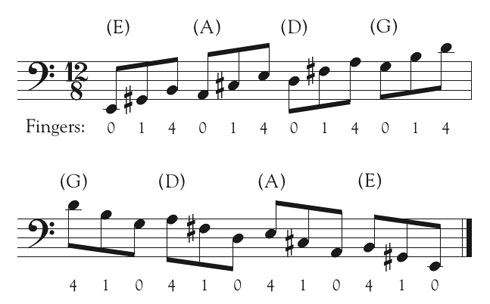
This also works going up or down on just one string, which I have dubbed the Philip Glass exercise.
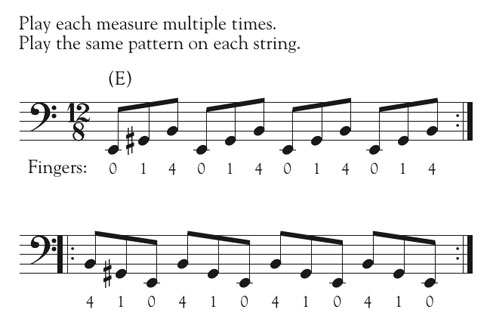
The bass I used this week was a Fender jazz bass, as opposed to the precision bass I started with or the short-scale bass I used briefly. My teacher said that he likes the jazz bass, but the one I buy should depend on the sound I like. My budget for the instrument is $500-$800, which will get me a good mid-line model. I took a brief look at amplifiers, for which my goal is to get the most inexpensive amplifier I can plug headphones into, and found one I liked for $99. My teacher agreed that skimping on an amp in exchange for a better bass was a good plan. Other expenses include a cord, a stand, and a case. I had a gig bag for my tuba, and while it was a lot easier to carry in a gig bag, it also got beaten up enough that I’m no longer a fan of gig bags and will be purchasing a hard case, which is probably another $100-$150.
Because I’m starting to get some rough fluency on finding notes, we spent part of today’s lesson playing a 12-bar blues in E, inspired by my teacher catching me playing

in the waiting room when he came to get me. Rather than having me do a walking bass line right away, he suggested I stick to roots of chords, over which he soloed on guitar. It’s a good feeling to play along with someone and feel like I’m contributing, even if it was just roots of chords. We went through nine or ten rounds of blues, and I started trying to add leading tones and work in basic scalar lines. It took me three times through to get this lead-in to the V chord correct

but it was a victory when I did.
We stopped and tried a second round of E blues at a much slower tempo, but with me playing the simple walking line he had caught me playing before the lesson. For measures 9-10, he recommended this:

After the blues, we went back to work on my assignments from the past week, followed by some time playing through Sunshine of Your Love at tempo. Time flew today.
The biggest takeaway for me, though, is that it’s much better to play standing up. When I sit, I get lazy fifteen different ways, but standing forces me to take posture and hand position seriously (plus it’s easier to see what I’m doing).
January 24
I bought a black Fender Aerodyne four-string jazz bass. I like the sound, it was easy to play, and several of the staff at the store admitted they had been considering it for themselves. Total cost with case, tuner, stand, cable, amp, and a three-year protection plan was just over $1,200. There’s still a lot of work to do, but I guess I’m officially a bassist now.
January 25: 20-Minute Practice Session
This was mostly a matter of setting everything up and figuring out what all the knobs on the bass and the amp do. My bass has two pickups (these are the bars that run under the strings), and what seems to be recommended is to turn one all the way up and the other 90% of the way up. Other than the volume knob on the amp, I left everything there alone. My amp came with a headphone jack, so I can practice in my apartment without shaking my neighbors’ windows.
January 26-27
Traveling this weekend; no practice.
January 28: 30-Minute Practice Session.
Today’s primary goal was work on arpeggios: 1-3-5, 5-3-1, and 1-3-5-8-5-3-1 in both major and minor keys. I also spent time reviewing major scales through the circle of fourths.
January 29: Last Lesson
Tonight felt like a celebration (as much as is possible on the eve of the –50° windchills that hit Illinois the next morning). I realize I have numerous advantages (such as a music degree) a typical beginning instrumentalist does not, but the progress I made was more than I thought was possible.
After reviewing everything from last week, we worked on the two-octave major scale for the bulk of the lesson. Although there are multiple fingering patterns that work, the easiest seems to be this one that requires sliding the first finger on all but the G string.
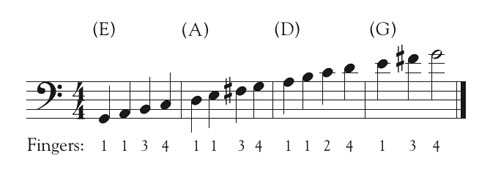
Epilogue
In late March (after more practice), I started playing bass at my church. The first performance was terrifying; I remember commenting that no matter how many times I’ve done it in the past, the first public performance on a new instrument feels awkward. I made mistakes, including both landing on the wrong fret and playing on the wrong string, but I survived. Subsequent performances have gotten much easier, in part because I still practice whenever I can, but also in part because I lived through that first performance. There are no substitutes for practicing diligently and getting performance experience, whatever the instrument.
